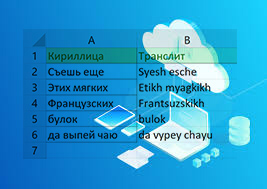This service translates given Hebrew letters into similar Latin characters.
Insert the sentence you want to transliterate in the area below:
The Hebrew alphabet, also known as the Hebrew script, consists of 22 letters. Here is a complete list of the letters of the Hebrew alphabet, along with their approximate pronunciation:
א (Aleph) - a silent vowel, usually not pronounced, but serves to indicate the sound value of other letters.
ב (Bet) - "b"
ג (Gimel) - "g"
ד (Dalet) - "d"
ה (Haf) - silent vowel "x"
ו (Vav) - "in" or "y" (in some cases)
ז (Zayin) - "z"
ח (Het) - guttural sound "x"
ט (Tet) - "t"
י (Yod) - "and" or "th"
כ (Kaf) - "to"
ל (Lamed) - "l"
מ (Meme) - "m"
נ (Nun) - "n"
ס (Sameh) - "with"
ע (Ain) - a pharyngeal sound that does not have an exact equivalent in Russian
פ (Drink) - "p"
צ (Tzadi) - "ts"
ק (Kof) - "to"
ר (Resh) - "r"
ש (Shin) - "sh" or "s"
ת (tav) - "t"
Each letter of the Hebrew alphabet also has a numerical value, and Hebrew is often used in the Jewish tradition to represent words and phrases numerically.
It is important to note that Hebrew is written from right to left, and therefore the order of the letters in the alphabet is from the last
letters (ת - Tav) to the first (א - Aleph).
Hebrew is a Semitic language which is the official language of Israel. Here are some features of the Hebrew language:
History: Hebrew is an ancient language with a rich history. For centuries, Hebrew has been used in religious and cultural texts such as the Torah, Hebrew literature, and Jewish prayer.
Alphabet: Hebrew is written using the Hebrew alphabet, which has 22 letters. The Hebrew alphabet was written from right to left.
Word Root: Most Hebrew words are made up of triconsonant roots that represent the stem of the word. By changing vowels and adding prefixes and suffixes, you can create different word forms and shades of meaning.
Semitic Roots: Hebrew belongs to the Semitic family of languages, so it shares some similarities with other Semitic languages such as Arabic. For example, Hebrew has plural nouns and verbs, as well as grammatical forms for masculine and feminine.
Gender: In Hebrew, words are masculine or feminine. It is also common in verbs, adjectives, and other parts of speech. The grammar rules and usage of masculine and feminine may differ.
Pronunciation: Hebrew has its own unique sounds and pronunciations. Some sounds may be unfamiliar to speakers of other languages, especially the sounds of guttural and pharyngeal consonants.
Modern Hebrew: In the 20th century, Hebrew was revived and became the modern state language of Israel. Modern Hebrew develops and is used in all aspects of life, including literature, education, business communication, and everyday speech.
Hebrew has its own unique features and is important to Jewish culture and heritage.

Comments
To leave a comment